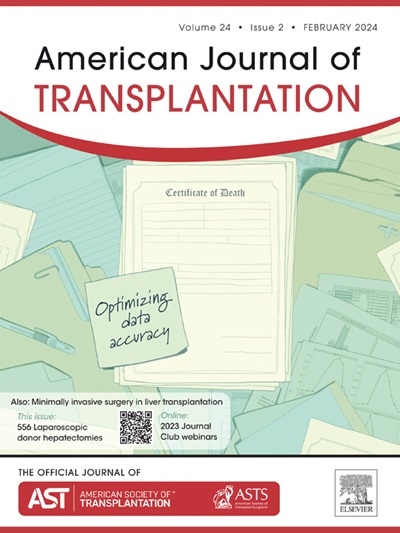The impact of the Banff v-lesion on rejection classification and outcomes: Insights from a multicenter study
IF 8.2
2区 医学
Q1 SURGERY
引用次数: 0
Abstract
According to the Banff classification, intimal arteritis (v-lesion) contributes to diagnosing T cell–mediated rejection (TCMR) and antibody-mediated rejection (AMR) and signifies more severe TCMR. This multicenter cohort study (N = 5323 kidney transplants, N = 16 774 posttransplant biopsies) evaluated the impact of v-lesions (N = 707 v-positive biopsies in N = 534 transplants) on biopsy classification and outcomes. The first v-positive biopsy of each transplant was categorized by additional Banff TCMR/(p)AMR-MVI criteria: 166 (31.1%) isolated v, 87 (16.3%) borderline changes with v, 66 (12.4%) TCMR grade I (TCMR-I) with v, 148 (27.7%) (p)AMR-MVI ((probable) AMR/DSAnegC4dneg MVI) with v, and 67 (12.5%) TCMR-I + (p)AMR-MVI with v. Cases with additional TCMR/(p)AMR-MVI criteria were more often indication biopsies, had lower eGFR, and were more frequently HLA-DSA positive than isolated v. While borderline changes with v had borderline higher 10-year graft failure rates than isolated v, TCMR-I, (p)AMR-MVI, and TCMR-I + (p)AMR-MVI with v were associated with significantly worse outcomes, although variably treated. Matching N = 534 v-positive cases to v-negative controls showed no significant impact of v-lesions on outcomes. These findings question the role of isolated v-lesions in rejection diagnosis and emphasize the greater prognostic value of additional TCMR and (p)AMR-MVI criteria. Reconsideration of v-lesions in the Banff classification may be appropriate.
Banff v型病变对排斥分类和结局的影响:来自多中心研究的见解。
根据Banff分类,内膜动脉炎(v-病变)有助于诊断T细胞介导的排斥反应(TCMR)和抗体介导的排斥反应(AMR),表明TCMR更严重。这项多中心队列研究(N=5323例肾移植,N=16774例移植后活检)评估了v型病变(N= 534例移植中N=707例v型阳性活检)对活检分类和结果的影响。每次移植的第一次v阳性活检根据额外的Banff TCMR/(p)AMR-MVI标准进行分类:分离v 166例(31.1%),伴v的交界性改变87例(16.3%),伴v的TCMR I级(tmri) 66例(12.4%),伴v的AMR-MVI 148例(27.7%)(p)AMR-MVI((可能)AMR /DSAnegC4dneg MVI),伴v的tmri + (p)AMR-MVI伴v的67例(12.5%)。附加TCMR/(p)AMR-MVI标准的病例比分离v更常进行活检,eGFR较低,HLA-DSA阳性。tmri + (p)AMR-MVI合并v与显著较差的结果相关,尽管采用不同的治疗方法。配对N=534例v-阳性病例和v-阴性对照显示,v-病变对结果没有显著影响。这些发现质疑了孤立的v型病变在排斥反应诊断中的作用,并强调了额外的TCMR和(p)AMR-MVI标准更大的预后价值。在Banff分类中重新考虑v型病变可能是合适的。
本文章由计算机程序翻译,如有差异,请以英文原文为准。
求助全文
约1分钟内获得全文
求助全文
来源期刊
CiteScore
18.70
自引率
4.50%
发文量
346
审稿时长
26 days
期刊介绍:
The American Journal of Transplantation is a leading journal in the field of transplantation. It serves as a forum for debate and reassessment, an agent of change, and a major platform for promoting understanding, improving results, and advancing science. Published monthly, it provides an essential resource for researchers and clinicians worldwide.
The journal publishes original articles, case reports, invited reviews, letters to the editor, critical reviews, news features, consensus documents, and guidelines over 12 issues a year. It covers all major subject areas in transplantation, including thoracic (heart, lung), abdominal (kidney, liver, pancreas, islets), tissue and stem cell transplantation, organ and tissue donation and preservation, tissue injury, repair, inflammation, and aging, histocompatibility, drugs and pharmacology, graft survival, and prevention of graft dysfunction and failure. It also explores ethical and social issues in the field.

 求助内容:
求助内容: 应助结果提醒方式:
应助结果提醒方式:


